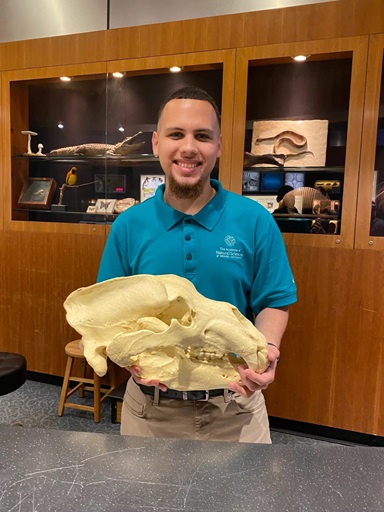Finding Latin American Inspirations in the Library and Archives
October 12, 2023
As the oldest natural history museum in North America, the Academy of Natural Sciences of Drexel University has a long and varied history. And even with the many well-known figures, works and stories found in its phenomenal Library and Archives, there are more that need to be researched, uncovered and revealed to help shape a brighter, more equitable future.
History major and recent co-op Nathan Nazario shares more in this interview originally published on the Academy's blog.

Tell us more about yourself.
I am a first-generation Puerto Rican student who grew up in North Philadelphia. I currently study history with a concentration in science, technology, and environment but I am also enrolled in a certification course to teach social studies and English to middle school students. During my co-op, I worked as a researcher with Professor Lloyd Ackert in the Library and Archives of the Academy of Natural Sciences. For me to be able to do research in America’s oldest natural history museum was a dream come true! It helped me come closer to my career goals, to one day become a history professor as well as conducting research for museums.
What was your inspiration?
The title of my research is Scientific “Fascinations”: Latin American Beasts, Lands, and People in the Views of 19th and 20th Century Naturalists and this idea came to be from the discussions I had with Dr. Ted Daeschler about the history of paleontology. I thought this was a fantastic idea, so I began brainstorming. I went to many different bookstores and libraries in hopes of finding topics. I’d figured I would use the topic of history of paleontology as a senior thesis, but once Prof. Ackert gave me the opportunity to do research with the Library and Archives at the Academy, I knew I had to narrow it down.
I noticed an overall lack of historical documents and books relating to the history of Latin American paleontology. Not only coming from a very prominent Latino area, but also having Hispanic descent, I knew this history must be found and displayed! However, with all the past scientists being captivated by Latin America, none of it is on display and there is a lack of historical documents to prove otherwise.
What did you learn?
What I learned was astonishing! For example, there was multiple plans to make some sort of South American museum here in Philadelphia, and in the Academy, there was attempts to make a Tropical Hall filled with different animals collected in Latin America. In the 1970s, a jaguar exhibit was made to fulfill this purpose but unfortunately it was short lived. Then, I also found that Edward D. Cope of the Academy collected South American Cenozoic (Ice Age) fossils from an Argentinian paleontologist by the name of Florentino Ameghino. Cope planned to put them on display in Fairmount Park as a permanent South American Cenozoic exhibit, but this did not come to fruition, which led this collection being sold to the American Museum of Natural History.
There are many more discoveries that happened, and plans made to convey this fascination, however, they did not go through with it. In my report, I illuminate the very rich history of the natural history and biodiversity of Latin America, along with the scientists who were fascinated by this “Lost and New World.”
What did your research in the Library and Archives entail?
I handled many different kinds of archival materials, which helped me learn how to look into history not on a surface level, but also deep into the meanings and ideas of the early history of the Academy. I got to look into the rare book collections, too; this section of the library was filled with books from ages ago and this information was on early studies of the natural sciences, as well as field journals from all around!
These books and archival materials helped me fully refine my ideas which led me to complete my research. I was able to work closely with the Academy’s education department to be able to not only view this research project from a professional lens but also in an educational program; to do this I created a program to teach all audiences about the history of sciences in Latin America during the Academy’s recent Dino-Mite Summer programming! This helped me further share my research with everyone, illuminating the rich history of Latin America, and get feedback as well.
Why do you feel this work is important?
It is important for people to recognize in the past, Latin America has always been overshadowed and sources have been taken away from them without the recognition they deserve. To dive into the Library and Archives and find limited sources on Latin American natural history made me realize that my research is important. I have the opportunity to tap into uncharted territory and craft a story from the Academy’s extensive history and set it differently and shine a light on topics the Academy has not shown in many years. And I can connect to other Latino students who want to see their history displayed in some way.
I hope my research can one day help students and museums learn about how to display other cultures and places in their environment. I am forever grateful for the Library & Archives at the Academy for having given me an experience that showed me how to become a true historian and researcher in the making.